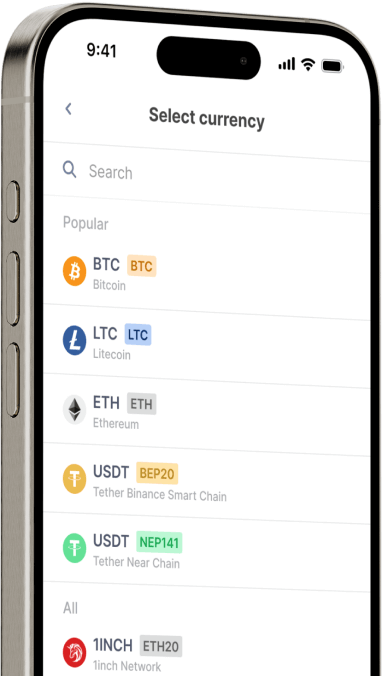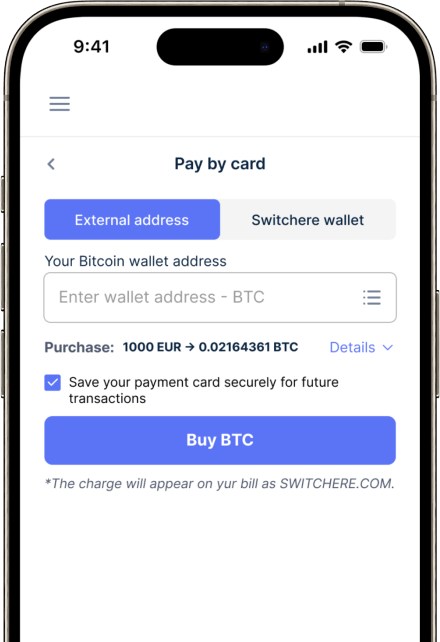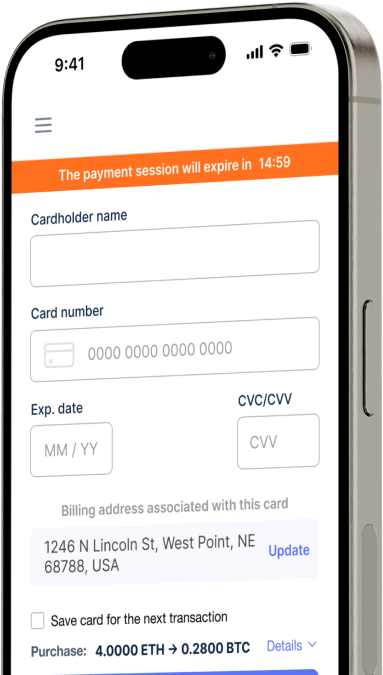Convertir
Romanian Leu (RON) a Curve DAO Token (CRV) al instante
Compre Curve DAO Token (CRV) con Romanian Leu (RON) fácilmente en Switchere y benefíciese de transacciones rápidas y seguras.
Acerca de
Curve DAO Token (CRV)
Curve DAO Token (CRV) es el token nativo de utilidad y gobernanza de Curve Finance, una bolsa descentralizada (DEX) de primer nivel y un protocolo de creador de mercado automatizado (AMM). Lanzado principalmente en la blockchain de Ethereum, Curve Finance se especializa en proporcionar un comercio extremadamente eficiente y una liquidez profunda para stablecoins y otros activos vinculados, como las variantes de Bitcoin envueltas, utilizando novedosos algoritmos de curva de vinculación diseñados para minimizar el deslizamiento. Este enfoque la convierte en una piedra angular del ecosistema financiero descentralizado (DeFi), en particular para las operaciones que requieren intercambios de activos estables dentro de diversas aplicaciones y estrategias DeFi.
La tecnología central detrás de Curve aprovecha los contratos inteligentes, escritos predominantemente en Vyper por seguridad y simplicidad, para crear grupos de liquidez altamente concentrados. Los tokens CRV son fundamentales para la tokenómica de la plataforma; los titulares pueden apostar CRV bloqueándolos para recibir CRV con voto en custodia (veCRV). Este veCRV otorga a los titulares poder de voto en la DAO de Curve para influir en los parámetros del protocolo, incluida la dirección de las emisiones de CRV a fondos de liquidez específicos a través de ponderaciones de calibre. Además, los titulares de veCRV tienen derecho a una parte de las comisiones de negociación del protocolo y pueden aumentar sus recompensas al proporcionar liquidez. Su papel a la hora de facilitar la liquidez de las stablecoins y la dinámica competitiva en torno a su gobernanza (a menudo denominada "Guerras de curvas") subrayan su importancia como activo digital fundacional en la cadena y componente de la infraestructura Web3.
Comprar otras 150+ criptomonedas por Romanian Leu (RON)
Otras monedas para Romanian Leu (RON)
-
RON a ZRX
-
RON a 1INCH
-
RON a AAVE
-
RON a ACH
-
RON a ALGO
-
RON a TLM
-
RON a ANKR
-
RON a APE
-
RON a NFT
-
RON a API3
-
RON a APT
-
RON a ARPA
-
RON a AUDIO
-
RON a AVAX
-
RON a AVAX
-
RON a AXS
-
RON a BADGER
-
RON a BAL
-
RON a BNT
-
RON a BAT
-
RON a BNB
-
RON a BSW
-
RON a BSV
-
RON a BLUR
-
RON a BONE
-
RON a CTSI
-
RON a CELR
-
RON a CELO
-
RON a CEL
-
RON a LINK
-
RON a CHZ
-
RON a CHR
-
RON a C98
-
RON a COMP
-
RON a CFX
-
RON a PEOPLE
-
RON a CVX
-
RON a ATOM
-
RON a CTC
-
RON a CRV
-
RON a DAI
-
RON a DASH
-
RON a MANA
-
RON a DENT
-
RON a DGB
-
RON a DYDX
-
RON a XEC
-
RON a EOS
-
RON a ETC
-
RON a ENS
-
RON a ETHW
-
RON a FET
-
RON a FIL
-
RON a FLOKI
-
RON a GALA
-
RON a GNO
-
RON a ONE
-
RON a HBAR
-
RON a HOT
-
RON a HOOK
-
RON a ICX
-
RON a ILV
-
RON a IMX
-
RON a INJ
-
RON a ICP
-
RON a IOST
-
RON a IOTX
-
RON a JASMY
-
RON a JST
-
RON a KAVA
-
RON a KCS
-
RON a KSM
-
RON a KNC
-
RON a LDO
-
RON a LQTY
-
RON a LPT
-
RON a LOOKS
-
RON a LRC
-
RON a LUNA
-
RON a MKR
-
RON a MASK
-
RON a EGLD
-
RON a ALICE
-
RON a NEAR
-
RON a XEM
-
RON a NEXO
-
RON a NOT
-
RON a NMR
-
RON a OKB
-
RON a OMG
-
RON a ONT
-
RON a EDU
-
RON a OP
-
RON a OGN
-
RON a CAKE
-
RON a PAXG
-
RON a PENDLE
-
RON a DOT
-
RON a POL
-
RON a QTUM
-
RON a QNT
-
RON a RDNT
-
RON a XRD
-
RON a RVN
-
RON a REN
-
RON a RSR
-
RON a RLC
-
RON a RPL
-
RON a SFP
-
RON a SHIB
-
RON a SKL
-
RON a SXP
-
RON a STND
-
RON a STG
-
RON a XLM
-
RON a GMT
-
RON a STORJ
-
RON a STMX
-
RON a SUSHI
-
RON a SNX
-
RON a USDT (Polygon)
-
RON a USDT (AVAC)
-
RON a USDT (BEP20)
-
RON a USDT (ERC20)
-
RON a USDT (SPL)
-
RON a USDT (NEP141)
-
RON a USDT (FA2)
-
RON a USDT (TRC20)
-
RON a USDT (JETTON)
-
RON a XTZ
-
RON a GRT
-
RON a SAND
-
RON a TFUEL
-
RON a THETA
-
RON a RUNE
-
RON a TON
-
RON a TUSD (BEP20)
-
RON a TUSD (TRC20)
-
RON a TWT
-
RON a UOS
-
RON a UMA
-
RON a UNI
-
RON a USDC (Polygon)
-
RON a USDC (SPL)
-
RON a USDC (OP)
-
RON a USDC (BEP20)
-
RON a USDC (AVAC)
-
RON a USDC (ARB)
-
RON a USDC (ERC20)
-
RON a VET
-
RON a VRA
-
RON a WAXP
-
RON a WOO
-
RON a WLD
-
RON a WBTC
-
RON a WMINIMA
-
RON a XDC
-
RON a YFI
-
RON a YGG
-
RON a ZIL
Cómo comprar Curve DAO Token (CRV)
Preguntas frecuentes
-
¿Cuál es el método principal para intercambiar RON por Curve DAO Token (CRV)?
Intercambiar RON por CRV generalmente implica un proceso de varios pasos utilizando exchanges descentralizados (DEX) y potencialmente un puente entre cadenas. Dado que RON es el token nativo de la Red Ronin y CRV es principalmente un token ERC-20 en Ethereum, probablemente primero usarías un DEX en Ronin, como Katana, para cambiar RON por un activo puenteado (por ejemplo, WETH o USDC). Luego, transferirías ese activo a la red principal de Ethereum y usarías un Creador de Mercado Automatizado (AMM) como Curve Finance o Uniswap para completar el intercambio por CRV. Este proceso requiere una billetera digital compatible y gestionar las tarifas de gas en ambas blockchains.
-
¿Cuál es el papel de los pools de liquidez y los AMM al operar el par de activos RON/CRV?
Dado que RON y CRV existen en blockchains diferentes, un pool de liquidez directo RON/CRV es poco común. En su lugar, los Creadores de Mercado Automatizados (AMM) en cada cadena respectiva facilitan los intercambios. En Ronin, un AMM como Katana utiliza pools de liquidez (por ejemplo, RON/WETH) para permitir a los usuarios intercambiar RON. En Ethereum, un AMM como Curve Finance utiliza sus pools especializados, a menudo para stablecoins o activos similares, para proporcionar un trading de bajo deslizamiento para activos como CRV. Los proveedores de liquidez (LP) financian estos pools con pares de activos y ganan comisiones, pero también están expuestos a riesgos como la pérdida impermanente.
-
¿Cuáles son las diferencias clave en las tarifas de transacción al intercambiar RON en comparación con intercambiar por CRV?
La diferencia principal radica en la blockchain subyacente. Intercambiar RON en la Red Ronin implica pagar tarifas de gas en RON, que históricamente están diseñadas para ser bajas para soportar el alto volumen de transacciones de los juegos. Por el contrario, intercambiar por CRV en su mercado principal, la red principal de Ethereum, requiere pagar tarifas de gas en ETH. Estas tarifas de gas de Ethereum pueden ser significativamente más altas y volátiles, a menudo medidas en Gwei, dependiendo de la congestión de la red. Una ruta de intercambio completa de RON a CRV incurriría en ambos tipos de tarifas: bajas tarifas de RON en Ronin y tarifas de ETH potencialmente altas en Ethereum.
-
¿Cuáles son las utilidades principales de los tokens RON y CRV dentro de sus respectivos ecosistemas?
RON sirve como el token de gas para la Red Ronin, una blockchain principalmente para juegos como Axie Infinity. Su utilidad incluye pagar transacciones, el staking de RON para asegurar la red a través de delegadores y validadores, y participar en la gobernanza. CRV es el token de gobernanza de Curve Finance, un importante protocolo DeFi. Su utilidad principal se realiza cuando se bloquea como veCRV (CRV con voto en custodia), lo que otorga a los titulares poder de voto en la DAO, una parte de las comisiones de trading del protocolo y la capacidad de aumentar las recompensas de los pools de liquidez.
-
¿Existen derechos de gobernanza asociados a la tenencia de RON o CRV obtenidos de un intercambio?
Sí, ambos tokens poseen capacidades de gobernanza. Tener RON te permite participar en la gobernanza de la Red Ronin al hacer staking con un validador. Los stakers pueden influir en los parámetros y la seguridad de la red. Para CRV, la gobernanza es más directa y poderosa. Al bloquear tokens CRV para recibir veCRV, los usuarios obtienen derechos de voto en la DAO de Curve. Estos votos determinan las actualizaciones del protocolo y, de manera crucial, dirigen la asignación de emisiones de CRV a diferentes pools de liquidez, una característica clave de las 'Curve Wars'.
-
¿Cómo puedo garantizar la seguridad al realizar un intercambio entre cadenas de RON a CRV?
La seguridad es primordial para las transacciones entre cadenas. Primero, utiliza solo puentes oficiales y de buena reputación, como el Puente Ronin oficial, para mover activos. Segundo, al usar DEX como Katana o Curve Finance, siempre verifica dos veces que estás interactuando con las direcciones de contrato inteligente correctas verificándolas en un explorador de bloques. Tercero, ten cuidado con la configuración de la tolerancia al deslizamiento; establecerla demasiado alta puede llevar a una ejecución comercial desfavorable. Finalmente, usa una billetera de hardware para firmar transacciones, ya que mantiene tus claves privadas fuera de línea y seguras de malware, proporcionando una capa crucial de protección para tus activos digitales.




